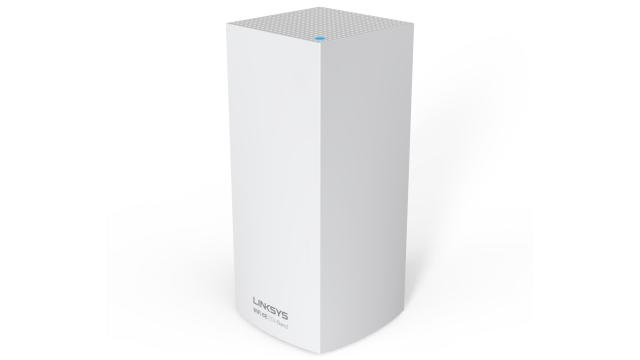I love CES time — that’s short for the Consumer Electronics Show — because that’s when we’re exposed to all kinds of outlandish devices that are fun to get excited about, but nothing you should add to your shopping list right now. And that’s especially true in the wide world of wireless networking. Linksys unveiled the AXE8400 tri-band router at this year’s show, and it’s a bit of an eye-opener in three different ways.
First, it’s a 4X4 MU-MIMO router that supports Wi-Fi 6E, the latest and greatest standard found in exactly zero devices you can buy right now. In other words, the AXE8400 is yet another “future-proofed” router geared for early adopters, or will be once it arrives in the spring or summer of this year.
Second, it costs a whopping $US450 ($581) for one router, and it’s really designed to be used in a mesh setup. Linksys, to its credit, gives you a deal on a two-pack — it’s $US850 ($1,098) for a pair of AXE8400 routers. But you’ll still be paying more for your routers than you would a new Mac Mini.
Finally, the router comes with built-in motion-sensing. Linksys bills this as a useful whole-home security feature and part of its separate “Linksys Aware,” service, which will run you $US3 ($4)/month or $US25 ($32)/year. Yes, that’s right: You router now comes with a subscription service, because hashtag revenue, but it’ll only notify you if it detects motion in your home. It won’t connect to any other smarthome system — not even your smartlights.
Editor’s Note: Stay tuned for local Australian pricing and availability.
However you feel about this particular high-priced router, there’s a larger lesson in all of this.
Stop buying routers because of their newness (or box copy)
I try to be accommodating with new technology launches. I get the excitement; I’ve covered the wireless networking industry for years. New standards come out, companies rush to be the first to market with routers that support them no matter what, and the devices typically cost a lot more than what you’d otherwise pay for a router in a year’s time or so.
However, I think it’s important to remember a critical piece of advice: Don’t buy a router that hasn’t been benchmarked by a number of reviewers in various situations. Ideally, you want to get a good representative sample of how a router performs in various real-life situations, instead of taking the word of that one reviewer who ran a few speed tests from another room and declared it the best wireless router ever assembled.
As wireless expert Dong Ngo puts it:
“Downloading a movie (or Netflix streaming for that matter) depends on the Internet speed, which has little to do with Wi-Fi. They are two different things.
Wi-Fi is the alternative to network cables — it allows for a local network without wires. So, the increased speed of Wi-Fi 6 is only meaningful locally, within your home or office.
In other words, assuming all of your devices are Wi-Fi 6-enabled, you’ll be able to print, perform network Time Machine backups, or stream from a local NAS server, etc., much faster.
As for the Internet, currently, the majority of residential broadband services offer speeds significantly below that of Wi-Fi 5, which is already plenty fast. Consequently, if you use Wi-Fi 6, you’ll experience no improvement at all in Internet access.”
Remember, just because a router is new, and just because it has different features that allow for higher maximum speeds, doesn’t mean that it’s the best on the market. And then there’s the price factor: Honestly, if I was building out the network for a reasonably sized house, I wouldn’t buy a two-access-point mesh system for $US850 ($1,098). I’d buy a bunch of prosumer gear and saturate that house with access points.
Most people don’t even have a super fast internet connection to begin with. And even those lucky enough to have a gigabit pipe gigabit fibre going into their homes would probably see a greater benefit from more access points around their house — even if they support a slower standard than Wi-Fi 6E, like “mere” Wi-Fi 6 or, gasp, Wi-Fi 5.
A Wi-Fi 6E router, like any router, is going to lose performance the farther away you are from it. I’d rather have a bunch of “Wi-Fi bubbles” giving me ~750Mbps downloads and file transfers across more areas of my home than one room in which the wireless maxes out north of 1Gbps, with a steady drop-off in wireless speed as I move away from there.
Yes, a wireless mesh setup can help address this issue, but then you’re also dealing with the occasional peculiarities of a wireless bridge. As always, I think the best solution for great wireless speeds at home is a classic one: scatter access points around your home, even if they only support 1Gbps wireless connections at most. That should be more than sufficient for your everyday needs, so long as your network does a good job about dumping you and your family’s/roommate’s/pet’s devices to the best (MU-MIMO) wireless access point as they walk around.
It’s fun to get excited about new technology. I’m sure there will come a time when Wi-Fi 5 will seem as ancient as wireless-n. For right now, don’t waste money on expensive Wi-Fi 6 “solutions” when you can do better, for less, with “slower” gear. Wait until you need that much networking firepower, and you’ll probably get a much better deal — and better access points.

Leave a Reply
You must be logged in to post a comment.